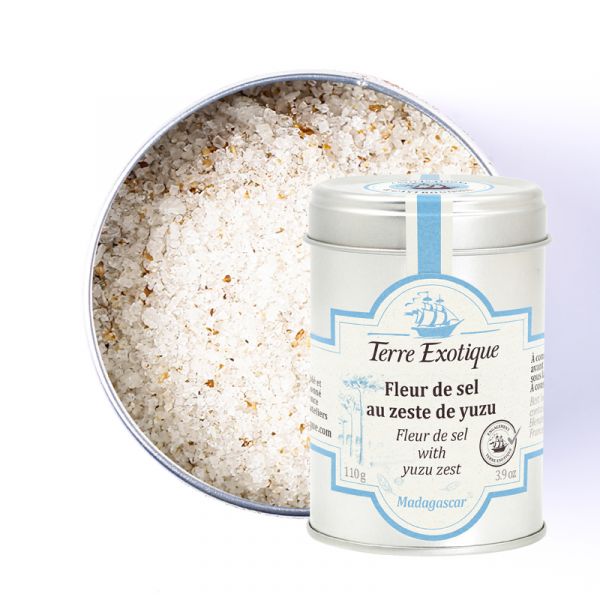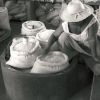







In What Dishes to Use Yuzu Fleur de Sel?
Yuzu is one of the ingredients in the Japanese Ponzu sauce made with soy sauce and yuzu juice. It is also one of the components of the Japanese spice blend, Shichimi Togarashi (also called Japanese curry), a perfect blend on grilled meat!
How to Use Yuzu Fleur de Sel?
Our recipe ideas to use yuzu fleur de sel in your cooking:
• yuzu vinaigrette: pour ½ tablespoon of miso into a bowl, add 3 tablespoons of rice vinegar, 1 teaspoon of yuzu fleur de sel, 5 tablespoons of olive oil, and some pepper;
• yuzu butter: add 3 teaspoons of yuzu fleur de sel to your softened butter;
• yuzu appetizer crackers: add 1.5 teaspoons of yuzu fleur de sel to your shortcrust pastry;
• yuzu shrimp salad: add ½ teaspoon of yuzu fleur de sel to your shrimp salad;
• yuzu chicken fillets: at the end of cooking, sprinkle 3 pinches of yuzu fleur de sel on your chicken fillets and enjoy.
- Yuzu zest parsnip soup: click here to discover the full recipe
The Intense Aromas of Yuzu and the Delicate Fleur de Sel
Yuzu has a taste similar to that of mandarin and yellow grapefruit. Both powerful and balanced, it is a condiment full of aromas. It is consumed in various forms: fresh, as juice, zest, powder, or even pearls. Married to the subtle and delicate fleur de sel from Madagascar, you won't be able to do without it.
Where Do Fleur de Sel and Yuzu Come From?
A Bit of Botany
Yuzu zest is native to Japan. Yuzu, also called Japanese lemon or Citrus reticulata, is the result of a cross between wild mandarin and lemon. This citrus, native to Tibet and China, grows wild. It is a tree of the Rutaceae family, which can reach up to 4 meters in height and can withstand temperatures as low as -15°C. Today, it is in Korea and Japan that it is most cultivated, where it is used in gastronomy, traditional medicine, but also in perfumery or in cosmetics.In the Southwest of the island of Madagascar, in Ifaty, are the salt marshes that give this delicious salt. The seawater contained in these clayey basins evaporates under the joint action of wind and sun. The fabulous result gives this fleur de sel that is not collected with a rake, but picked by hand with great delicacy. This is how its light and airy texture can be preserved without breaking.
Stories and Traditions
Yuzu, a Citrus with Multiple Uses
Yuzu is native to East Asia, particularly China and Tibet, where it grows wild. It was introduced to Japan during the Tang Dynasty around 700 AD. In Japan and Korea, it is used in cuisine, but also in traditional medicine to fight against fatigue and pain. In Japan, yuzu is also traditionally infused in the bath to soften the skin and fight against fatigue thanks to its invigorating effects. In Korea, the wood of the yuzu tree is used to make musical instruments such as the taepyeongso.
Madagascar Fleur de Sel and Its History
The nickname of the island of Madagascar is "Africa with Asian eyes." Its salt marshes are far from any pollution, in Ifaty, southwest of the island. Since always, the fleur de sel of Ifaty has been harvested by the Vezo, an ethnic group of fishermen living on this side of the island. Originally, this ethnic group lived off fishing, but little by little the resources of the island decreased, so they began to harvest the fleur de sel of Ifaty, pure and immaculate, because only they possess the know-how for this harvest.
| Allergen | Absence |
|---|---|
| Native country | MADAGASCAR |
| Ingredients | fleur de sel, yuzu zest (2%). |
| Nutritional Info | VN Energie pour 100 g (energy for 100g) : 29 kJ / 7 kcal VN Matière grasse (fat) : 0 g Dont acide gras saturés (of which saturated fat) : 0 g VN Glucides (carbohydrate) : 1.6 g Dont sucres (of which sugars) : 1.2 g VN Protéines (protein) : 0.1 g Vn Sel (salt) : 92.2 g |
| TRACES EVENTUELLES D'ALLERGÈNES | céleri, sésame, moutarde, fruits à coques. |
 Français
Français 